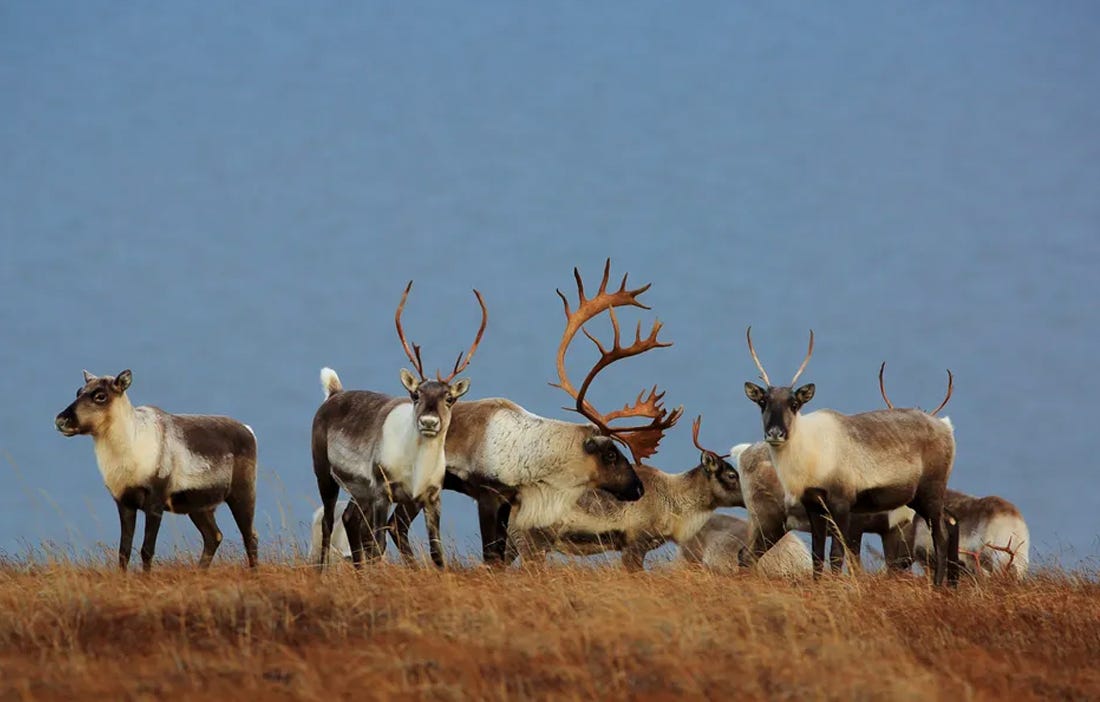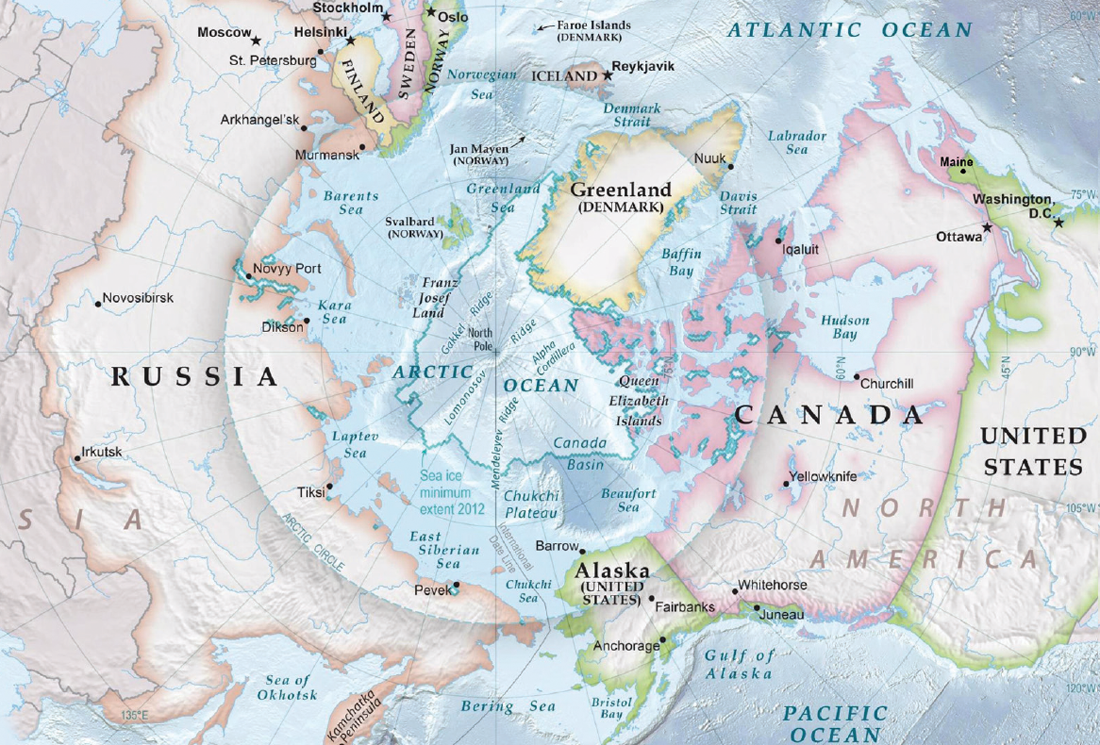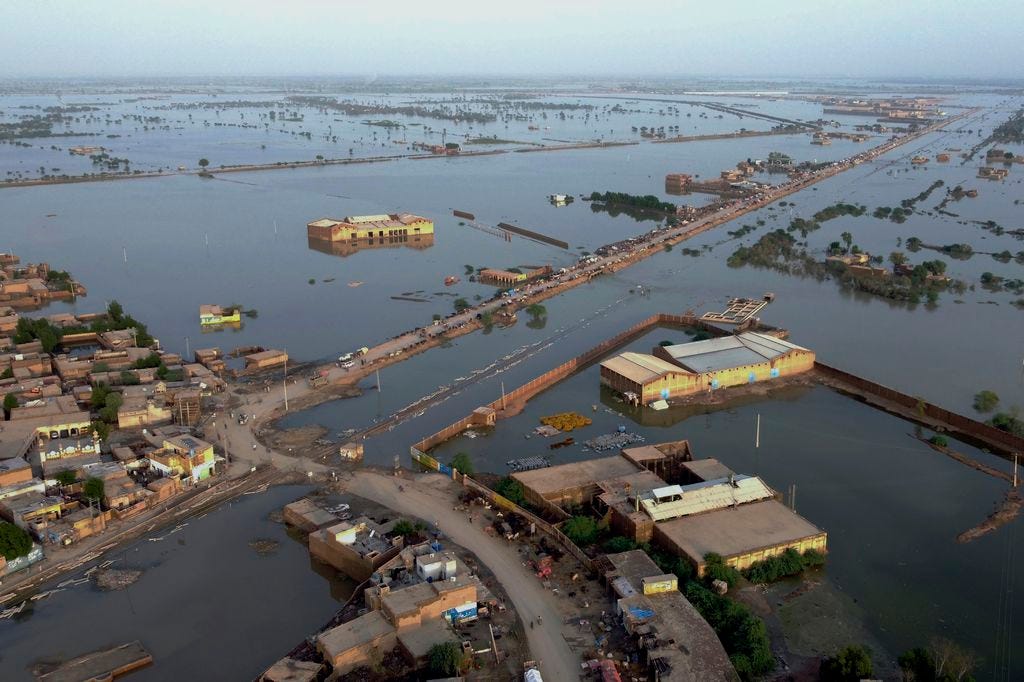What a Week
Hello doomers, The world changes every day now. Even though there's a glow of hope in Joe Biden
The reasons may be darker than the crude Itself.

Earlier this year, Joe Biden approved the $8 billion Willow oil and gas drilling project on Alaska’s North Slope, in spite of outrage from environmentalists and Native Alaskan communities, who correctly point out it will speed up #ClimateChange and further undermine indigenous people’s food security, and culture. Three approved sites will include up to 199 wells on 68,000 acres.
The ConocoPhillips project will be one of the largest in the US, and is projected to have a life of three decades on the largest tract of public land in the country, the 23 million-acre National Petroleum Reserve.
Significantly, Interior Secretary Deb Haaland, who fought Willow as a member of Congress, was silent on the project, which was signed not by her, but rather her deputy, Tommy Beaudreau, who grew up in Alaska and has a close relationship with Alaskan Republican Senator Lisa Murkowski. An ardent proponent of Willow, Murkowski cleverly agreed to support Haaland, Biden’s pick for Interior Secretary, despite concerns about the nominee’s far-left environmental record. This enabled Murkowski to stay in Biden’s ear about Willow, and her support paid off. Beaudreau, whose portfolio as a lawyer included fossil fuel drilling and pipeline firms, has a reputation for being friendlier to oil and gas interests.
Up to 2,500 jobs could be created during construction, but only 300 long-term jobs.
Estimated production is 600 million barrels over 30 years, peaking at 180,000 barrels of crude a day. Complicating the project, ConocoPhillips has said it may need to refreeze rapidly thawing Arctic permafrost to stabilize its drilling equipment. Also disturbing, production of these fields could negate all the reductions of renewable energy projects on public lands combined by 2030, and in fact produce more than twice as many emissions as those efforts offset.
Willow will create around 260 million tons of greenhouse gases over its lifespan, equivalent to 70 new coal-fired power plants. In my last article, The Real Eco Terrorists, I pointed out Alaska has at least 31 indigenous communities facing the loss of their villages from rising seas and melting permafrost. Currently, there is little to no federal assistance for these people and the Arctic is melting at a far faster rate than climate scientists anticipated, easily seen by satellite observations, and measurements. The melting of the Arctic and Greenland ice sheets would guarantee the submerging of US coastlines, including the metropolises of NYC and Miami.
Grassroots Alaska-based collective, the Native Movement, has pointed out Willow developers have done little research on the impact of cumulative projects across the Arctic slope which are the birthing grounds for the 60,000 Teshekpuk Lake caribou herd, which provides a critical food source. In the closest Alaska Native community, Nuiqsut, just 36 miles away, people depend on hunting and fishing for their traditional, sustainable lifestyle. They have spoken out about sick fish, malnourished caribou, and toxic air, caused by already existing oil and gas extraction.

Biden’s words, “No more drilling on federal lands. Period. Period. Period,” delivered to voters in New Hampshire, in February 2020 have proven false. The seriously compromised Inflation Reduction Act of 2022 (IRA) which I wrote about here, made enormous concessions to the fossil fuel industry by making renewable energy projects on federal lands and waters contingent on selling new drilling leases, and gaining environmental approvals for ten years. Willow is the most egregious development to date. Why is Biden doing this? I strongly suspect it’s about far more than Senator Murkowski bringing jobs to Alaska.
Not spoken of, but likely in the thinking of this project, is competition with Russia and China, as the Arctic melts. Brand new trade routes will emerge, and competition for trillions of dollars of previously unavailable natural resources (planet warming fossil fuels among them) will be tense. Willow makes no sense until you consider it militarily. With the possibility of world supply chains breaking down from climate change, having an oil supply in the region becomes part of national security strategy.

The military realized climate change is the number one security threat to the US decades ago, at least as early as 1990. Thanks to the Freedom of Information Act, this declassified 87-page publication from the Department of the Navy, Global Climate Change Implications for the United States Navy, proves this. A few excerpts:
“This paper presents an overview of the mechanism of global climate change and their related societal effects and addresses, in broad terms, the impacts upon various areas of naval planning. Global warming, as a major feature and driver of climate change, is a complex issue. However, the presentation of information regarding the causes and predicted global consequences of these phenomena is necessary to enable the reader to attain a clear understanding of the gravity of the problem, the potential seriousness of the impact, and the complex difficulties which will be encountered in attempting to address the Navy’s long-range plans.”
“In some of these nations such as Egypt, India, and Bangladesh, major segments of the populations and significant portions of their agricultural capacity exist in low-lying areas or along river basins. As the climate changes, sea level rise may well inundate these areas with salt water...producing major damage to the economies, health, and quality of life in nations ill-equipped to face the challenge.”
“While developed nations possess far greater resources to deal with adaptive measures required by global warming, the impact upon their societies will form a tremendous hardship, forcing difficult choices. In developed nations such as the United States, tremendous investments are at risk in the coastal regions.”
This report was primitive in its understanding of climate change. Even the words “global warming” are out of date. Our scientific understanding has grown tremendously since, and we are now experiencing the serious consequences of changing weather patterns. Droughts are more severe and extended. Additional moisture from evaporation is fueling larger, slower moving storms. When precipitation comes, it’s heavier from melting glaciers, and ocean evaporation. It rolls over the hard, parched ground, rather than being absorbed, causing devastating flooding. These conditions threaten the very viability of agriculture and drinking water. That threatens social order. The US military recognized this scenario long ago, and the previously inaccessible Arctic is destined to become a point of contention.
The 1990 Navy report, was just the beginning. Numerous studies recognizing the threat of climate change to national security are available. How many classified reports exist, I can’t know. Public reports can be found on at US government site, Center for Climate and Security (CCS). Sources include the Department of Defense, Navy, Marine Corps, Coast Guard, and US Military War College. This page contains links to the 1990 Navy report, and subsequent papers from 2003 through 2022.
The Council on Strategic Risks (CSR) is an umbrella for the CCS (numerous recent reports here), the Converging Risks Lab (CRL), reports here, and the Janne E. Nolan Center on Strategic Weapons. Each entity is informed by large teams of current and retired military, intelligence, and security experts whose profiles can easily be found on the home pages. Studying these publications, in detail, would require months of work. However, simply considering the seriousness of the people involved, the sheer number of publications, reading some of them, and reviewing the mandates on each home page reveals the gravity with which the military regards climate change.
A few highlights from my investigation:
From the Climate and Security Advisor Group (CSAG), also part of CCS, page nine of their 49-page 2019 report A Climate Security Plan for America makes a statement that pertains precisely to the point of this article, Russian and Chinese interest in the Arctic, among other sobering considerations:
“New and evolving risks will shape the security environment of the next decade and beyond. Climate change is a threat that shapes the entire geostrategic environment, including our relationship with key regional powers, near peer competitors, rogue states and fragile nations – and in profoundly destabilizing ways. Russia and China, for example, are expanding their influence into the Arctic because the ice is receding. Tension between India and Pakistan is influenced by Pakistan’s water shortfalls and India’s control over Pakistan’s supply of fresh water, which is in turn influenced by shrinking Himalayan glaciers. Violent extremist organizations take advantage of water and food insecurity to enhance their leverage over adversaries and local populations. Climate change isn’t separate from other threat priorities. Rather, it significantly exacerbates and complicates other threats.”
“By the end of the century, Americans and others around the globe face the possibility of many feet of sea-level rise and coastal cities that may need to be abandoned; hundreds of millions of displaced persons around the world; billions of new people globally requiring more energy, more food, and more water, and a climate that makes that more difficult to accommodate; new weather patterns, a million lost species, and major disruptions to natural resources around the world; and potentially wide-reaching changes in the global order. The near-term risks are significant and must be managed, but the medium and long-term may pose security crises that we must take steps to avoid.”
In January 2021, the Department of the Navy released A Strategic Blueprint for a Blue Arctic. This document also recognizes the loss of Arctic ice will become a focus of Russia and China. As new shipping lanes become available from ice melt, previously inaccessible natural resources will become the interest of exploitation. From the document:
“The coming decades will witness significant changes to the Arctic Region. Encompassing about six percent of the global surface, a Blue Arctic will have a disproportionate impact on the global economy given its abundance of natural resources and strategic location. The region holds an estimated 30% of the world’s undiscovered natural gas reserves, 13% percent of global conventional oil reserves, and one trillion dollars’ worth of rare earth minerals. Of the oil and gas reserves present in the Arctic, an estimated 84% likely reside offshore. Fish stocks are expected to continue to shift northward, attracting global fishing fleets and creating potential challenges to the current international prohibition on Arctic fishing.”
“While only a fraction of global maritime activity transits the Arctic today, commercial activity is increasing through key strategic chokepoints such as the Bering Strait, Bear Gap, and Greenland-Iceland-United Kingdom (GIUK) Gap. The projected opening of a deep-draft trans-polar route in the next 20-30 years has the potential to transform the global transport system.”
“Russia is investing heavily to enhance its Arctic defense and economic sectors, with a resultant multilayered militarization of its northern flank. By modernizing its military capabilities and posture – particularly the Northern Fleet – Russia aims to improve command and control, infrastructure, and joint force employment to project power and defend its northern approaches. In doing so, the escalatory and non-transparent nature of Russia’s military activity and unlawful regulation of maritime traffic along the Northern Sea Route undermines global interests, promotes instability, and ultimately degrades security in the region.”
“The People’s Republic of China views the Arctic Region as a critical link in its One Belt One Road initiative. As witnessed in other regions, a combination of Chinese capital, technology, and experience has the potential to influence Arctic shipping routes and undermine the economic and social progress of peoples and nations along these routes. China is investing in ship building – polar-capable cargo vessels, liquefied natural gas tankers, and nuclear-powered icebreakers – as well as port infrastructure to improve access in the Arctic. China’s investments, global fishing fleet, and scientific, economic, and academic linkages to the people and institutions of Arctic nations, including joint ventures with Russia, will likely continue to rise in the decades ahead...China’s growing economic, scientific, and military reach, along with its demonstrated intent to gain access and influence over Arctic States, control key maritime ports, and remake the international rules-based order presents a threat to people and nations, including those who call the Arctic Region home.”
“The new National Intelligence Estimate on climate, a first-of-its kind document by the Office of the Director of National Intelligence, builds on other grim warnings from national security officials about how a changing climate could upend societies and topple governments.”
“We assess that climate change will increasingly exacerbate risks to U.S. national security interests as the physical impacts increase and geopolitical tensions mount about how to respond to the challenge," the document states. It also concludes that while momentum is growing to reduce global emissions of greenhouse gases, "current policies and pledges are insufficient" to meet the goals that countries laid out in the landmark Paris climate accord.”
The document goes on to warn of eleven countries at immediate acute risk: Afghanistan, Colombia, Guatemala, Haiti, Honduras, India, Iraq, Myanmar, North Korea, Nicaragua and Pakistan. Many of these countries have already been irreversibly damaged by climate change, possess nuclear weapons, and have shaky governments at best.

From the National Archives we can read Executive Order 14008, in its entirety, addressing the threat of climate change. Excerpts:
“The United States and the world face a profound climate crisis. We have a narrow moment to pursue action at home and abroad in order to avoid the most catastrophic impacts of that crisis and to seize the opportunity that tackling climate change presents. Domestic action must go hand in hand with United States international leadership, aimed at significantly enhancing global action. Together, we must listen to science and meet the moment.”
Section 101. Policy. United States international engagement to address climate change—which has become a climate crisis—is more necessary and urgent than ever. The scientific community has made clear that the scale and speed of necessary action is greater than previously believed. There is little time left to avoid setting the world on a dangerous, potentially catastrophic, climate trajectory. Responding to the climate crisis will require both significant short-term global reductions in greenhouse gas emissions and net-zero global emissions by mid-century or before.
Section one goes on to charge practically every level of government with specific directives in the crisis, including The Secretary of the Treasury, Secretary of State, Secretary of Energy, Director of National Intelligence, The Secretary of Defense and the Chairman of the Joint Chiefs of Staff, and Secretary of Homeland Security.
Sec. 201. Policy. Even as our Nation emerges from profound public health and economic crises borne of a pandemic, we face a climate crisis that threatens our people and communities, public health and economy, and, starkly, our ability to live on planet Earth...
It is the policy of my Administration to organize and deploy the full capacity of its agencies to combat the climate crisis to implement a Government-wide approach that reduces climate pollution in every sector of the economy; increases resilience to the impacts of climate change; protects public health; conserves our lands, waters, and biodiversity; delivers environmental justice; and spurs well-paying union jobs and economic growth, especially through innovation, commercialization, and deployment of clean energy technologies and infrastructure. Successfully meeting these challenges will require the Federal Government to pursue such a coordinated approach from planning to implementation, coupled with substantive engagement by stakeholders, including State, local, and Tribal governments.
The Willow project, of course, profoundly undermines the language of the last paragraph. ConocoPhillips is the third-largest emitter of greenhouse gasses and the eighth-largest producer of hydrocarbons among US oil companies. Oil drilling by definition destroys land, pollutes water, and cannot be called an innovative technology. Stakeholders? Let’s call them what they are, shareholders. Fossil fuels endanger human life, animal life, and undermine social justice, in this case most directly, the people of the Tribal governments, indigenous people who have caused the least harm, and have been the victims of genocide and persecution since the arrival of the first colonists.
Biden knows all of this, but faces realities all empires face, as they try to hang onto power. The greatest threat we face is not Russia, or China, but the planet itself. Putin and Xi Jinping met recently, as they attempt to forge a relationship to dominate the US. These are realities Biden faces. Willow is a result of this thinking, a forced geopolitical chessboard move, that steals resources we desperately need, to change how we live on earth. It’s age-old political maneuvering. The problem, it’s now an extinction level game.
Read more of Geoff's work here.
Escape wishful thinking.